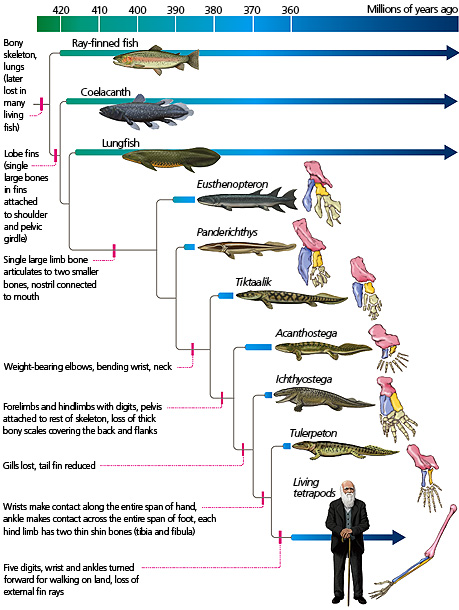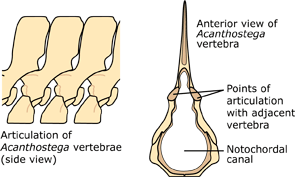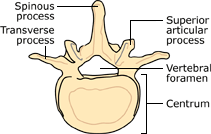How Did Fish Evolve Into Land Animals
The word "tetrapod" means "iv anxiety" and includes all species alive today that take iv anxiety — but this group too includes many animals that don't take four feet. That'southward because the group includes all the organisms (living and extinct) that descended from the last common antecedent of amphibians, reptiles, and mammals. So, for example, the ichthyosaur, an extinct pond reptile, is a tetrapod even though it did non apply its limbs to walk on land. So is the snake, even though it has no limbs. And birds and humans are tetrapods fifty-fifty though they only walk on two legs. All these animals are tetrapods because they descend from the tetrapod ancestor described above, even if they have secondarily lost their "four anxiety."

Tetrapods evolved from a finned organism that lived in the water. Nonetheless, this ancestor was non like near of the fish we are familiar with today. Most animals we call fishes today are ray-finned fishes, the group nearest the root of this evogram. Ray-finned fishes comprise some 25,000 living species, far more than all the other vertebrates combined. They have fin rays — that is, a system of frequently branching bony rays (called lepidotrichia) that emanate from the base of the fin.
In contrast, the other animals in the evogram — coelacanths, lungfishes, all the other extinct animals, plus tetrapods (represented by Charles Darwin) — have what nosotros call "fleshy fins" or "lobe fins." That is, their limbs are covered by muscle and skin. Some, such as coelacanths, retain lepidotrichia at the ends of these fleshy limbs, merely in most fleshy-finned animals these have been lost.
The mutual ancestor of all those different organisms (ray-fins, coelacanths, lungfishes, tetrapods, etc.) was neither a lobe-fin nor a ray-fin. This ancient vertebrate lineage had fins (with lepidotrichia), scales, gills, and lived in the water. Notwithstanding they also had air bladders (air-filled sacs) connected to the back of their throats that could be used for breathing air (i.eastward., as lungs) or for buoyancy command. The air bladders of many ray-fins no longer connect to their throats, and so they are not able to breathe air. In these ray-fins, the air bladder is used mainly for buoyancy control and is known equally a swim bladder. By contrast, tetrapods have taken an alternative road: they have lost the buoyancy control function of their air bladders, and instead this organ been elaborated to class the lungs that we all use to get effectually on state.
When we get past coelacanths and lungfishes on the evogram, we find a series of fossil forms that lived betwixt about 390 and 360 million years ago during the Devonian Period. During this interval, this lineage of fleshy-finned organisms moved from the water to the land. Many parts of the skeleton changed as new innovations that permitted life on land evolved.
For example, the ancestors at the base of this evogram lived fully in the water and had skulls that were tall and narrow, with eyes facing sideways and forwards. This allowed them to wait around in their watery environments for predators and prey. Notwithstanding, as ancestors of the first tetrapods began to live in shallower waters, their skulls evolved to be flatter, with eyes on the tops of their heads. This probably immune them to look upward to spot nutrient. And then, as tetrapods finally moved fully onto state and away from the h2o, many lineages once over again evolved skulls that were alpine and narrow, with eyes facing sideways and forwards, allowing them to look effectually their terrestrial environments for predators and casualty.
As lineages moved into shallower water and onto land, the vertebral column gradually evolved every bit well. Y'all may accept noticed that fishes have no necks. Their heads are simply connected to their shoulders, and their private vertebrae look quite similar to one another, all the way downwards the body. Mobile necks allow land animals to look down to see the things on the footing that they might want to eat. In shallow water dwellers and country dwellers, the first cervix vertebra evolved different shapes, which allowed the animals to movement their heads upwards and down. Eventually, the second cervix vertebra evolved too, allowing them to move their heads left and right. Afterward tetrapods evolved necks with seven or more vertebrae, some long and some brusk, permitting even more than mobility.
The vertebrae you are probably most familiar with (like our own!) consist of a spool-like centrum, which connects in front and back with other centra. On top of the centra are vertebral spines and arches to which musculus segments attach, and lateral to the centra are the ribs; these anchor muscles that flex as the animals motion. Fishes swim with simple lateral motions, so their arches are relatively straight and needle-like, and so are their ribs. When you eat fish and pick out the bones, these are mostly what you're finding. Because fishes alive in the water, gravity is not a big problem for them. Simply on state, a quadruped with a backbone between forelimbs and hindlimbs faces the same problems as a bridge designer: sag. As the fleshy-finned organisms began to venture onto land, they evolved a serial of interlocking articulations on each vertebra, which helped them overcome sag and hold the backbone straight with minimal muscular effort.
 |  |
The connection between the pelvis and hindlimbs in early tetrapods is a prime example of exaptation. We call this fused connexion the sacrum. It is extremely useful for terrestrial organisms considering it allows them to use their hindlimbs efficiently for locomotion on land. Since the aquatic ancestors of fishes and tetrapods had no such connexion, one might guess that this feature first evolved serving the function of enabling terrestrial locomotion. Nonetheless, the earliest grade of this connectedness (equally seen in Acanthostega) evolved while these tetrapod precursors were still living in the water. Based on current show, Acanthostega appears to have been fully aquatic, so this connection likely evolved to office in something other than terrestrial locomotion. Only afterwards, as tetrapod ancestors moved onto country, was this trait co-opted for terrestrial back up — and as information technology was, additional vertebrae were fused in the aforementioned style, providing further support.
As the limbs and their connections to the rest of the skeleton evolved, limb bones took on singled-out roles and many bones were lost. The humerus and the femur were already connected to ii outer bones (the radius and ulna in the forelimb, the tibia and fibula in the hindlimb). This is something that evolved about 30 1000000 years before vertebrates came onto land. However, muscular connections betwixt these bones began to change on the road to land and allowed the limbs to be used for terrestrial locomotion. The ankle was originally composed of many small bones arranged in two rows, merely gradually many of these pocket-sized bones were lost. The first animals to go shut to walking on land had eight digits on each limb. Over fourth dimension, some of these digits were lost, leading to animals with seven digits, then vi, and and so five, which is the common condition now seen in living tetrapods.
As these animals evolved to live on state, other changes in the residual of their bodies evolved. Many would eventually lose their gills, which merely work well for getting oxygen when wet, and their tail fins got smaller. Similarly they lost the lateral line organization, a network of vibration-sensitive canals along the skull and jaw, which doesn't piece of work out of water.
The environments of the animals shown in this evogram also inverse through time. In fact, if you were to venture dorsum to Arizona at the showtime of the "Age of Dinosaurs" in the Triassic Period, some 225 million years ago, you would find ray-fins, coelacanths, and lungfishes living in the marshes, streams, and temporary ponds of that twenty-four hours, along with freshwater sharks. So the habitats that these animals occupy today are not necessarily the ones in which they have ever lived, or in which they originally evolved. It is still unclear exactly where the transition from h2o to country took place ecologically. Paleontologists accept discovered fossils involved in this transition preserved from freshwater, brackish, and marine habitats. Regardless of where the transition occurred, eventually early ancestors of the kickoff tetrapods came up onto land — although not all stayed. Some, like the whales, made the transition back into the water.
Source: https://evolution.berkeley.edu/what-are-evograms/the-origin-of-tetrapods/
Posted by: johnsonsniters.blogspot.com

0 Response to "How Did Fish Evolve Into Land Animals"
Post a Comment